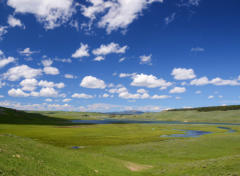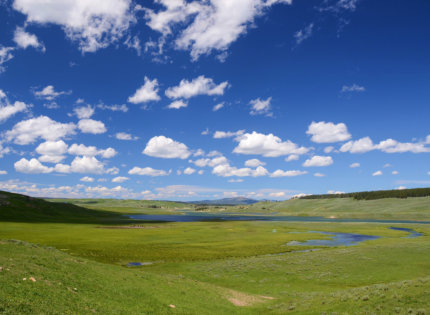
HISTORY ONLINE 24/7/365
WESTWARD EXPANSION
Westward Expansion in U. S. History 2
The massive migration westward, spurred by the discovery of gold in California in 1849, increased after the Civil War with advances in transportation such as the Transcontinental Railroad, in technologies that enabled the settlement of the Great Plains, and new discoveries of gold and silver. While this created new opportunities for many, it also led to coflict, as settlers and Native Americans competed for territory and resourcesResources:
Union Pacific Railroad Museum Central Pacific Railroad Photographic History Museum Golden Spike National Historic Site California State Railroad Museum National Westward Expansion Museum at the Gateway Arch PBS Webpage on the Ghost Dance and the Battle of Wounded Knee (this page contains the script for a segment from the PBS series The West we used to watch in class but is not longer available online During the nineteenth century, people’s perceptions and use of the Great Plains changed. Technological advances allowed people to live in more challenging environments Physical features and climate of the Great Plains • Flatlands that rise gradually from east to west • Land eroded by wind and water • Low rainfall • Frequent dust storms Because of new technologies, people saw the Great Plains not as a “treeless wasteland” but as a vast area to be settled. Inventions • Barbed wire • Steel plows • Windmills • Railroads Adaptations • Dry farming • Sod houses • Beef cattle • Wheat farming Advances in transportation linked resources, products, and markets. Manufacturing areas were clustered near centers of population. Transportation resources • Moving natural resources to eastern factories (e.g., iron ore to steel mills) • Transporting finished products to national markets • Locating factories near rivers and railroads to move resources and finished goods to markets Examples of manufacturing areas • Textile industry: New England • Automobile industry: Detroit • Steel industry: Pittsburgh • Meatpacking industry: Chicago New opportunities and technological advances led to westward migration following the Civil War. Westward expansion had an impact on the lifestyle of American Indians. Reasons for increase in westward expansion • Opportunities for land ownership • Technological advances, including the Transcontinental Railroad • Possibility of obtaining wealth, created by the discovery of gold and silver • Desire for adventure • Desire for a new beginning for former enslaved African Americans Impact on American Indians • Opposition by American Indians to westward expansion (Battle of Little Bighorn, Geronimo) • Forced relocation from traditional lands to reservations (Chief Joseph, Nez Percé, Sitting Bull) • Reduced population through warfare (Battle of Wounded Knee), disease, and reduced buffalo population • Assimilation attempts and lifestyle changes (American Indian boarding schools, Dawes Act) • Reduced American Indian homelands through broken treatiesU.S. Mapping Games:
Click to start here with a simple tutorial Drag and Drop by Region Drag and Drop Click on the State Drag and Drop (Harder)

PHYSICAL REGIONS
Looking for the physical regions
of North America from the
Virgina Standards of Learning
for U. S. History I?




































HISTORY ONLINE 24/7/365
mrbower.com
WESTWARD EXPANSION
Westward Expansion in U. S. History 2
The massive migration westward, spurred by the discovery of gold in California in 1849, increased after the Civil War with advances in transportation such as the Transcontinental Railroad, in technologies that enabled the settlement of the Great Plains, and new discoveries of gold and silver. While this created new opportunities for many, it also led to coflict, as settlers and Native Americans competed for territory and resourcesResources:
Union Pacific Railroad Museum Central Pacific Railroad Photographic History Museum Golden Spike National Historic Site California State Railroad Museum National Westward Expansion Museum at the Gateway Arch PBS Webpage on the Ghost Dance and the Battle of Wounded Knee (this page contains the script for a segment from the PBS series The West we used to watch in class but is not longer available online During the nineteenth century, people’s perceptions and use of the Great Plains changed. Technological advances allowed people to live in more challenging environments Physical features and climate of the Great Plains • Flatlands that rise gradually from east to west • Land eroded by wind and water • Low rainfall • Frequent dust storms Because of new technologies, people saw the Great Plains not as a “treeless wasteland” but as a vast area to be settled. Inventions • Barbed wire • Steel plows • Windmills • Railroads Adaptations • Dry farming • Sod houses • Beef cattle • Wheat farming Advances in transportation linked resources, products, and markets. Manufacturing areas were clustered near centers of population. Transportation resources • Moving natural resources to eastern factories (e.g., iron ore to steel mills) • Transporting finished products to national markets • Locating factories near rivers and railroads to move resources and finished goods to markets Examples of manufacturing areas • Textile industry: New England • Automobile industry: Detroit • Steel industry: Pittsburgh • Meatpacking industry: Chicago New opportunities and technological advances led to westward migration following the Civil War. Westward expansion had an impact on the lifestyle of American Indians. Reasons for increase in westward expansion • Opportunities for land ownership • Technological advances, including the Transcontinental Railroad • Possibility of obtaining wealth, created by the discovery of gold and silver • Desire for adventure • Desire for a new beginning for former enslaved African Americans Impact on American Indians • Opposition by American Indians to westward expansion (Battle of Little Bighorn, Geronimo) • Forced relocation from traditional lands to reservations (Chief Joseph, Nez Percé, Sitting Bull) • Reduced population through warfare (Battle of Wounded Knee), disease, and reduced buffalo population • Assimilation attempts and lifestyle changes (American Indian boarding schools, Dawes Act) • Reduced American Indian homelands through broken treatiesU.S. Mapping Games:
Click to start here with a simple tutorial Drag and Drop by Region Drag and Drop Click on the State Drag and Drop (Harder)

PHYSICAL REGIONS
Looking for the physical regions of
North America from the Virgina
Standards of Learning for U. S.
History I?



































































